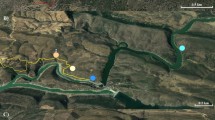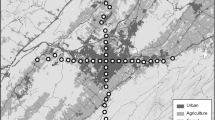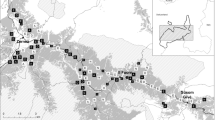Abstract
The main objective of this study was to determine the extent of influence that a large city's ecological conditions have on the singing behaviour of urbanised birds. The singing activity of selected bird species was examined using the “animal focus sampling” method. The observations were carried out from the beginning of March to the beginning of June 1995 in a 10 ha inner city park, the Westpark (WP) in Dortmund (NRW, Germany). An area of equal size in a forest south of Dortmund, the Niederhofer Wald (NW) was chosen as a control area. In the Westpark the Blue Tit, Great Tit and Chaffinch started to sing significantly earlier in the morning than in the control area. This difference could be due to the artificial lighting of the park at night as well as the noise of traffic.
There was no difference in the three species' singing activities between the two areas, but there were differences in the temporal pattern of the Chaffinch's morning singing activity in comparison of the two areas. In the Niederhofer Wald the Chaffinch was almost equally active at all times whereas it showed a pattern similar to the Tit's “dawn chorus” in the Westpark. Food supply, distribution and predictability within the two areas are discussed as causes for this difference. However, the negative correlation between singing activity and the frequency of pedestrians crossing the birds' territories may also play a role.
In the Westpark, a correlation between the Chaffinch's singing activity and the frequency of passing pedestrians was noted. The more people crossed the focus animal's territory, the less its singing activity and the more frequently “pinks” occurred. Thus, pedestrians do indeed disturb the Chaffinch which reacts with a change of singing behaviour.
Zusammenfassung
Das Ziel der vorliegenden Arbeit war, festzustellen, ob und inwieweit sich die besonderen ökologischen Bedingungen in einer Großstadt auf das Gesangsverhalten urbanisierter Vögel auswirken. Von Anfang März 1995 bis Anfang Juni 1995 wurde die Gesangsaktivität ausgewählter Vogelarten in einem 10 ha großen innerstädtischen Park in Dortmund (Westpark) mit Hilfe der „animal focus sampling“-Methode untersucht. Als Referenzfläche diente ein ebenso großer Flächenausschnitt aus einem an der südlichen Stadtgrenze Dortmunds liegenden Waldgebiet (Niederhofer Wald). Blaumeise (Parus caeruleus), Kohlmeise (Parus major) und Buchfink (Fringilla coelebs) begannen morgens im Westpark signifikant früher zu singen als im Kontrollgebiet. Dieser Verhaltensunterschied wird auf die nächtliche Beleuchtung des Parks sowie den Straßenlärm zurückgeführt. Die Gesangsaktivität von Blaumeise, Kohlmeise und Buchfink unterschied sich zwischen den beiden Gebieten nicht. Hingegen ließ sich eine signifikante Abweichung zwischen dem zeitlichen Verlauf der Gesangsaktivität der Buchfinken im Westpark und dem im Niederhofer Wald nachweisen. Während Buchfinken im Wald im Verlauf einer Begehung etwa konstant gesangsaktiv waren, nahm die Gesangsaktivität des Buchfinken im Verlauf des Morgens im Park stark ab. Als Ursache für die unterschiedliche zeitliche Organisation des Gesangsverhaltens werden das Angebot, die Verteilung und die Vorhersehbarkeit der Nahrung in den beiden Gebieten diskutiert. Möglicherweise spielt dabei aber auch der im Westpark festgestellte Einfluß der Personenfrequenz eine Rolle. Mit zunehmender Zahl der Personen, die das Revier des Focus-Tieres betraten, nahmen die Gesangsaktivität ab und die Häufigkeit der Erregungsrufe („pink“-Rufe) zu. Personen stellen demnach für den Buchfink einen Störreiz dar, auf den er mit einer Verhaltensänderung reagiert.
Similar content being viewed by others
Literatur
Altmann, J. (1974): Observational study of behaviour: sampling methods. Behaviour 49: 227–267.
Avery, M. I., &J. R. Krebs (1984): Temperature and foraging success of Great Tits Parus major hunting for spiders. Ibis 126: 33–38.
Bergmann, H.-H. (1987): Die Biologie des Vogels. Wiesbaden.
Ders. (1993): Der Buchfink: Neues über einen bekannten Sänger. Wiesbaden.
Bezzel, E. (1982): Vögel in der Kulturlandschaft. Stuttgart.
(1988): Die Gesangszeiten des Buchfinken (Fringilla coelebs): Eine Regionalstudie. J. Orn. 129: 71–81.
Blana, H. (1990): Bioökologischer Grundlagenund Bewertungskatalog für die Stadt Dortmund. Teil 4, „Dortmund-Süd“. Dortmund, Umweltamt.
Bortz, J., G. A. Lienert &K. Boehnke (1990): Verteilungsfreie Methoden in der Biostatistik. Berlin, Heidelberg, usw.
Bühl, A., &P. Zöffel (1994): SPSS für Windows Version 6.0. 1. Aufl. Addison — Bonn, Paris, N. Y.
Daan, S. (1976): Light intensity and the timing of daily activity of Finches (Fringillidae). Ibis 118: 223–236.
Elvers, H. (1977): Die Brutvögel des Waldfriedhofes Heerstraße 1974. Orn. Ber. Berlin (West) 2: 139–150.
Erz, W. (1956): Der Vogelbestand eines Großstadtparks im westfälischen Industriegebiet. Orn. Mitt. 8: 221–225.
(1959): Der Vogelbestand im Wohnviertel einer Großstadt im westfälischen Industriegebiet. Orn. Mitt. 11: 221–227.
(1964): Populationsökologische Untersuchungen an der Avifauna zweier nordwestdeutscher Großstädte. Z. für wiss. Zool. 170: 1–111.
Freude, M. (1984): Der Gesang des Buchfinken (Fringilla c. coelebs) Bestandsaufnahme, Analyse und Aspekte der Evolution. Diss. Humboldt-Universität, Berlin.
Glutz von Blotzheim, U. N. (1993): Handbuch der Vögel Mitteleuropas. Band 13/I, Passeriformes (4. Teil). Wiesbaden.
Gottlander, K. (1987): Variation in the song rate of the male Pied Flycatcher (Ficedula hypoleuca): causes and consequences. Anim. Behav. 35: 1037–1043.
Greig-Smith, P. W. (1982): Song-rates and parental care by individual male Stonechats (Saxiola torquata). Anim. Behav. 30: 245–252.
Gutzwiller, K. J., R. T. Wiedenmann, K. L. Clements &S. H. Anderson (1994): Effects of human intrusion on song ocurrence and singing consistency in subalpine birds. Auk 111: 28–37.
Gwinner, E. (1975): Circadian and circannual rhythms in birds. In:Farner, D. S., J. R. King &K. C. Parkes): Avian biology. 5: 221–285.. N. Y.
Haartman, L. von (1952): Über den Einfluß der Temperatur auf den morgendlichen Gesangsbeginn des BuchfinkenFringilla coelebs. L. Orn. fennica 29: 73–76.
Hanski, I. K., &A. Laurila (1993): Variation in song rate during the breeding cycle of the ChaffinchFringilla coelebs. Ethology 93: 161–169.
Henwood, K., &A. Fabrick (1979): A quantitative analysis of the dawn chorus: temporal selection for communicatory optimization. Am. Nat. 114: 260–274.
Heymann, J. &H.-H. Bergmann (1988): Incomplete song strophes in the Chaffinch (Fringilla coelebs): general influences on a specific behavioural output. Bioacustics 1: 25–30.
Kacelnik, A. (1979): The foraging efficiency of Great Tits (Parus major L.) in relation to light intensity. Anim. Behav. 27: 237–241.
&J. R. Krebs (1983): The dawn chorus of Great Tit (Parus major): proximate and ultimate causes. Behaviour 83: 287–309.
Luniak, M. (1981): The birds of the park habitats in Warsaw. Acta orn. 18: 335–370.
Ders. &R. Mulsow (1988): Ecological parameters in urbanisation of the European Blackbird. Acta XIX Congr. Int. Orn. Ottawa 1787–1793.
Mace, R. (1989): A comparison of Great Tits use of time in different daylengths at three European sites. J. Anim. Ecol. 58: 143–151.
McFarland, D. (1989): Biologie des Verhaltens: Evolution, Physiologie, Psychobiologie. Weinheim.
McNamara, J. M., R. H. Mace &A. I. Houston (1987): Optimal daily routiness of singing and foraging in a bird singing to attract a mate. Behav. Ecol. Sociobiol. 20: 399–405.
Mulsow, R. (1976): Die Avicoenose der Gartenstadt. Vogelwelt 28: 55–68.
Oelke, H. (1974): Siedlungsdichte. In:Berthold, P., E. Bezzel &G. Thielcke, Praktische Vogelkunde: 33–44. Greven.
Reid, M. L. (1987): Costliness and reliability in the singing vigour of Ipswich sparrows. Anim. Behav. 35: 1735–1743.
Scheer, G. (1952): Über den Einfluß der Temperatur auf den morgendlichen Gesangsbeginn des Buchfinken in verschiedenen Jahren. Orn. fennica 29: 77–82.
Strain, J. G., &R. L. Mumme (1988): Effects of food supplementation, song playback, and temperature on vocal territorial behaviour of Carolina Wrens. Auk 105: 11–16.
Witt, K. (1978): Überblick über Siedlungsdichte-Untersuchungen in Berlin (West). Orn. Ber. f. Berlin (West) 3: 15–34.
Ydenberg, R. C. (1984): The conflict between feeding and territorial defence in the Great Tit. Behav. Ecol. Sociolbiol. 15: 103–108.
Author information
Authors and Affiliations
Rights and permissions
About this article
Cite this article
Bergen, F., Abs, M. Verhaltensökologische Studie zur Gesangsaktivität von Blaumeise (Parus caeruleus), Kohlmeise (Parus major) und Buchfink (Fringilla coelebs) in einer Großstadt. J Ornithol 138, 451–467 (1997). https://doi.org/10.1007/BF01651380
Published:
Issue Date:
DOI: https://doi.org/10.1007/BF01651380




